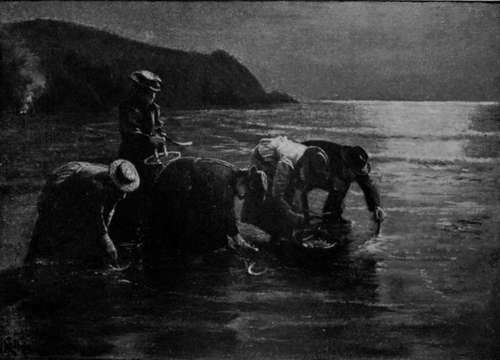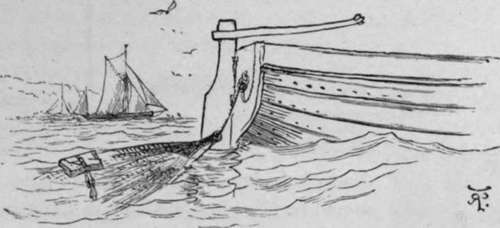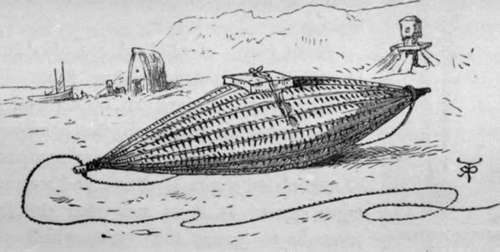The Sand Eel Or Launce
Description
This section is from the book "Sea Fishing", by John Bickerdyke. Also available from Amazon: Sea Fishing.
The Sand Eel Or Launce
The Sand Eel Or Launce is not only a valuable bait, but also a very important source of food to most species of sea fish. There are two varieties, the lesser and the greater. It is known by numerous local names, which are occasionally used in a loose and very perplexing manner. In Scotland the greater sand-eel is termed homer or horn eel, in Cornwall the great hint; the St. Ives fishermen calling adult eels snake bait, and the young ones naked bait; in Ireland (co. Down) they are termed snedden. The lesser sand-eel is called the lizard bait at Land's End, and the wriggle in Sussex.

Two-Hook Tackle.

Sand-eels, which, by the way, are capital eating, except in the winter soon after they have spawned, are generally caught either by digging or raking them out of the sand at low water, or by enclosing them in seines which are specially made for the purpose. The sand-eel seine—a Channel Island institution—consists of a strip of netting (sometimes as much as seventy yards in length) of various sizes of mesh, the mesh decreasing from the sides towards the bunt or middle, which is of calico. In it are some gores of exceedingly fine netting, placed there to allow the water to pass through it. This calico, some thirty feet in length, cut fuller than the rest of the net, forms a sort of bag which takes the little fish when the net is drawn on shore. The netting immediately next the calico, which, like the calico, should be gathered to make it bag, is of one-inch mesh, the wings on the outside being of three-inch mesh. The seine may be about eighteen feet deep in the centre, tapering off to five feet at the sides.

Scraping For Sand Eels By Moonlight.

Courge In Tow. 29" X 9 Ins.

The LID.
This net—the measurements given are those used by professional fishermen— is unnecessarily large for the amateur.
When caught, the sand-eels should be kept alive as long as possible in wickerwork baskets of the form shown in the illustration, called courges, and much used for towing after boats. These great conveniences, in which shrimps and small flat fish can also be kept alive, can now be obtained from the Plymouth tackle-makers. Used alive the sand-eel is one of the most deadly baits known for pollack and bass. It should be placed on the hook in the manner shown in the illustration (fig. a) if the tidal current is at all strong ; but in slack water it is perhaps best hooked through the nape of the neck, as shown in fig. b. Dead sand-eels are good whiffing baits, and it is not as a rule necessary to spin them. The whiffing or trailing tackle used for small congers or silver eels, shown on pp. 96-99, carries the sand-eel exceedingly well. But, should the fish be very shy and a lively spin be deemed desirable, a Chapman spinner, small in the fans and long in the spike, is as good as any that can be used, but it must be fitted with hooks strong enough to hold the fish we are seeking.

Courge.


Baiting With The Living Sand-eel.
Small pieces of sand-eel are also good baits for most bottom-feeding fish. For whiffing purposes they can be kept for an almost indefinite period in the compound known as King's Preservative, or a mixture of methylated spirits, glycerine, and water in equal parts. It is as well after the first fortnight to change the liquid, which gets charged with oil.
Continue to:
Tags
fishing, hooks, bait, fishermen, spanish mackerel, mackerel fishing
